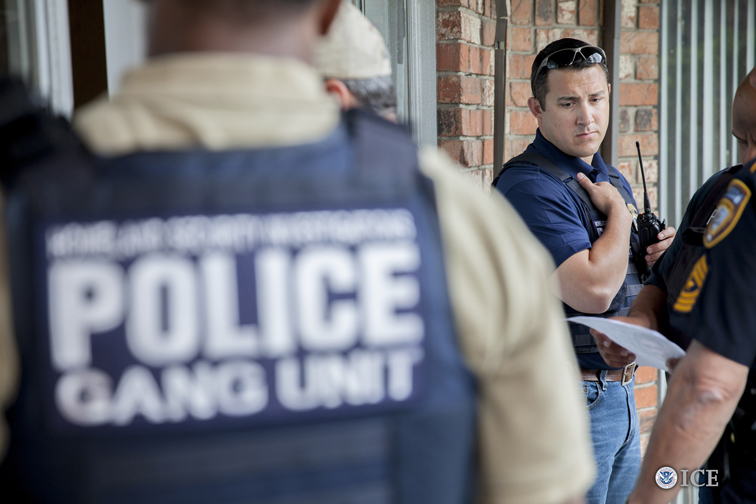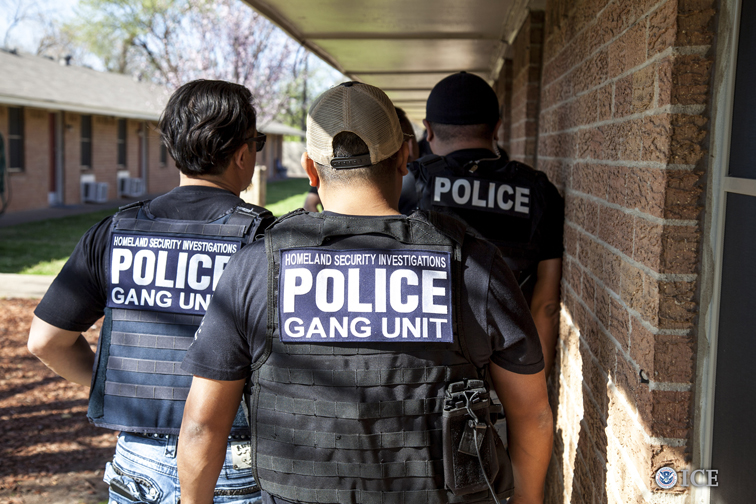A Decade of Success
In what began as an international effort to disrupt and dismantle violent and dangerous transnational street gangs more than a decade ago, U.S. Immigration and Customs Enforcement (ICE) Homeland Security Investigations (HSI) National Gang Unit (NGU) recently announced the results of a large gang operation in May 2017, the latest coordinated surge activity within Operation Community Shield.
Identifying and arresting suspected gang members and their criminal associates has always been a top priority for ICE’s NGU. In 2005, ICE initiated Operation Community Shield, an international law enforcement initiative that combines ICE HSI’s expansive statutory and civil enforcement authorities to combat the growth and proliferation of transnational criminal street gangs, prison gangs and outlaw motorcycle gangs throughout the United States.

Results
Since its inception, the results from Operation Community Shield have been impressive; including more than 40,000 arrests, more than 8,000 firearms taken off the streets and the total value of all seizures, including real estate, automobiles, narcotics and cash is rapidly approaching $100 million. In addition, more than 550 known and suspected gang leaders were among those arrested through Operation Community Shield enforcement activities since 2005.
According to the National Drug Intelligence Center and other law enforcement sources, street gangs, along with outlaw motorcycle gangs and prison gangs are the primary distributors of illegal drugs in the United States. Additionally, the Department of Justice explained in its 2006 National Drug Threat Assessment, for example, that the increased availability of methamphetamines in the Northeast, Southeast, and Great Lakes regions of the country is in part attributable to the proliferation of Hispanic gangs such as the Latin Kings and MS-13 in these areas.
Through Operation Community Shield and the NGU, ICE and its law enforcement partners have also succeeded in combatting this threat to our communities through a number of targeted, nationwide enforcement actions during the initiative’s first 10 years. In addition to the recently concluded gang surge in May 2017, other examples include Operation Crystal Palace, a pair of investigations conducted by the HSI San Diego Gang Investigations Group and netted 82 arrests, more than 110 firearms, approximately 25 lbs. of methamphetamine, and nearly $100,000 in U.S. currency between 2010 and 2014.

Project Devil Horns
Another significant example of the impact Operation Community Shield is having can be seen further north, in San Francisco’s historic Mission District, the site of Project Devil Horns, an HSI-led criminal investigation of a local chapter of the transnational Mara Salvatrucha, or MS-13 street gang known as “20th Street MS.” The 20th Street MS gang included approximately 140 active members, mostly foreign nationals from Central America, with many verified as being present in the United States illegally. The 20th Street MS clique was a criminal enterprise participating in a variety of criminal activities including murder, attempted murder, extortion, drug distribution, illegal sales of firearms, burglary, robbery, assaults on rival gang members, and vehicle theft.
HSI San Francisco agents and the NGU collaborated with the Department of Justice Gang Squad trial attorneys in pursuit of RICO convictions for most of those arrested through Project Devil Horns. More than 30 individuals were charged and although most individuals pled guilty, eleven went to trial and nine of those were convicted. In total, seven defendants were sentenced to life in federal custody and 20 others received sentences of 7 – 35 years in custody.
As a result of Project Devils Horns many acts of violence and crimes committed in the San Francisco area were resolved. Without question, ICE HSI’s investigation led to a safer environment for the entire community and the major disruption of a long entrenched MS-13 clique in San Francisco.

Operation Barbed Wire
In 2011, ICE HSI launched Operation Barbed Wire, a collaborative initiative with the U.S. Department of Treasury, Office of Foreign Asset Controls. This successful collaboration led to the designation of MS-13 as a Transnational Criminal Organization (TCO) pursuant to Executive Order (EO) 13581, signed by President Obama on July 25, 2011. This important designation provides the Treasury Department with the authority to target TCOs for economic sanctions.

Moving Forward
While overall violent crime statistics reveal a steady decline over the last few decades, the presence of violent transnational street gangs, as well as the amount and violent nature of the criminal activity they support, presents on ongoing challenge to law enforcement at every level. And although it is estimated that a large percentage of gang-related crime takes place in and around major metropolitan areas, the influence of violent criminal street gangs is not limited to America’s inner cities.
In fact, according to ICE HSI and the NGU, there is evidence that transnational immigrant gangs are spreading out across the United States, in suburban and rural areas as well as in established urban street gang environments, with MS-13 activity found in 48 states, Washington, D.C., and Puerto Rico.
The continued spread of transnational criminal street gangs throughout the country also presents an opportunity for local governments and local law enforcement agencies to strengthen their relationship with ICE, whether it is through increased local training opportunities for their officers or key information sharing through community outreach initiated by ICE. Gang-related enforcement activity is much more effective in areas where the partnership between ICE HSI and local law enforcement is strongest.









